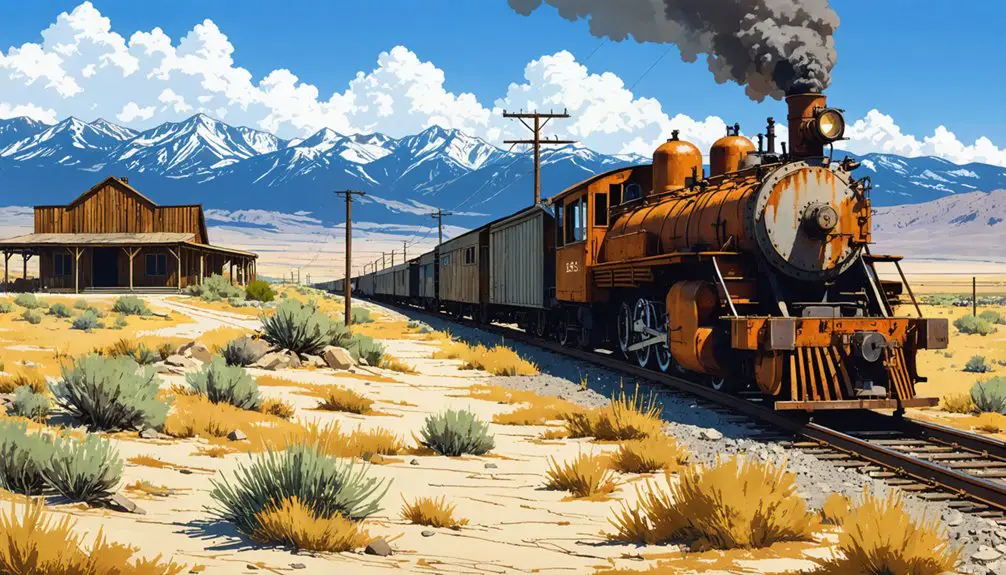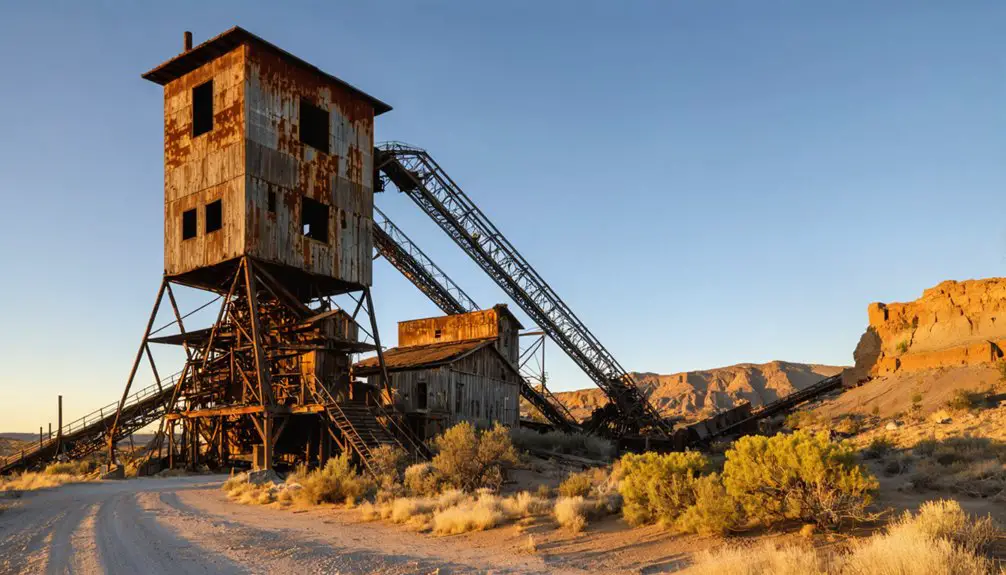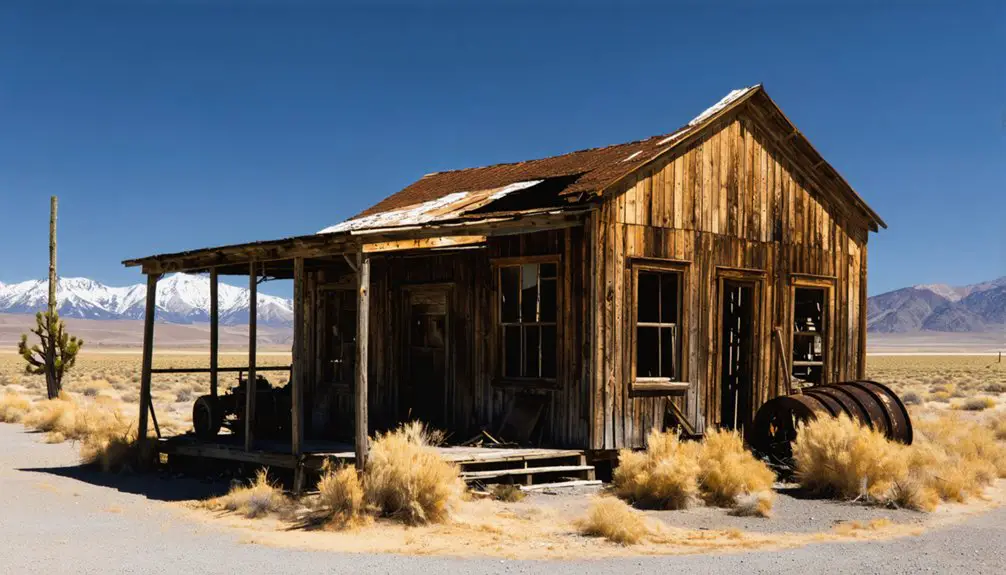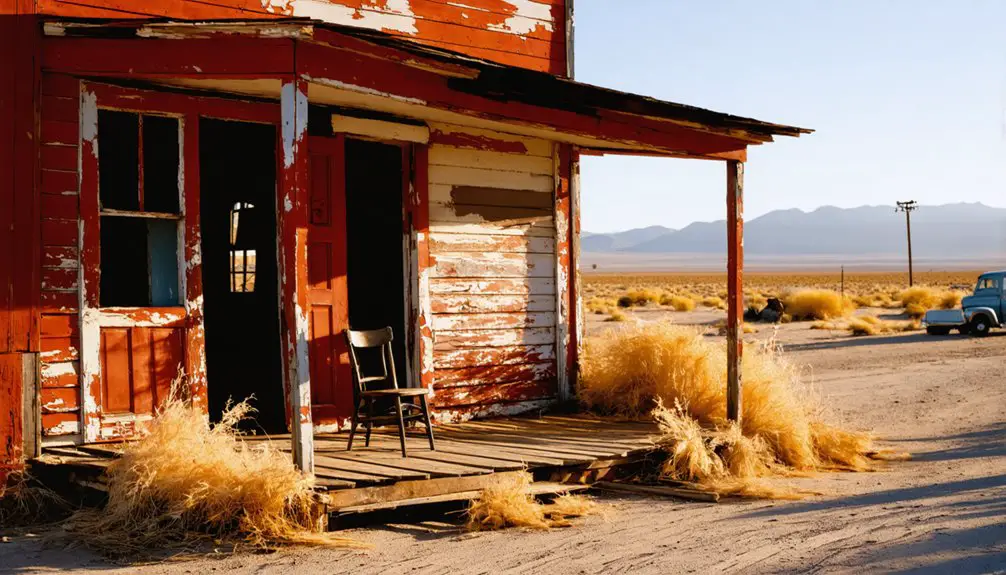You’ll discover Ruth, Nevada’s historic copper mining town in White Pine County, where over 200 million pounds of copper were extracted during its 1929 peak. Founded after a 1897 mining claim, it grew into a strictly controlled company town with 2,300 residents at its height. While mining continues today at Liberty Pit, Ruth’s preserved structures, Nevada Northern Railway Museum, and Commercial Club offer glimpses into its fascinating copper empire legacy.
Key Takeaways
- Ruth began as a copper mining town in 1903, reaching its peak population of 2,300 residents before declining due to mining operations.
- The town was controlled by Nevada Consolidated Copper Company, which provided housing and essential services for workers.
- Mining operations continued until May 1978, marking the end of Ruth’s primary economic activity and initiating its transition to ghost town status.
- Today, Ruth exists as both an active mining community and heritage site, featuring the historic Nevada Northern Railway Museum.
- The town’s original location was moved multiple times to accommodate expanding mining operations, with major relocations completed by 1932.
Birth of a Copper Mining Empire
Although the Ruth mining claim initially yielded minimal gold and silver deposits when D.C. MacDonald discovered it in 1897, the site’s destiny changed when Edwin Gray and Dave Bartley began tunneling operations.
The discovery of Ruth’s true potential emerged not from its modest beginnings, but from the visionary tunneling work that followed.
Their copper discoveries in 1902 transformed the area into a bustling mining district, attracting Mark Requa who purchased the claim and organized the White Pine Copper Company across 304 acres.
The formation of Nevada Consolidated Copper Company marked a turning point, especially after the Guggenheim family took control in 1906. By 1929, the operation had achieved record production levels of over 200 million pounds of copper.
Their mining innovations revolutionized the industry with the Liberty Pit project in 1907, one of America’s first large-scale open-pit copper mines. The massive excavation grew to become one mile long and reached depths of 900 feet.
You’ll find the impact of these developments reflected in Ruth’s rapid growth as a company town, complete with worker housing and essential infrastructure to support the booming copper empire.
The Town Behind the Mines
You’ll discover that Ruth’s early community life centered around a strictly controlled company town environment, where Nevada Consolidated Copper Company provided all housing and services while prohibiting vices like saloons and brothels.
The company’s paternalistic approach shaped every aspect of daily life, from the neat arrangement of worker housing to the provision of essential amenities like hospitals and boarding houses. When mine expansion necessitated change, the town was physically relocated to accommodate the growing operations. By 1932, Kennecott Corporation had acquired majority ownership of Nevada Consolidated, further solidifying its influence over the town’s development.
Despite these restrictions, Ruth’s residents created their own social dynamics, often seeking entertainment in nearby towns like Riepetown while building a community that reached its peak population of 2,300 before the Great Depression.
Early Community Life
Ruth’s early community life centered around three key pillars: company-controlled housing, essential services, and strict social regulations.
You would’ve found yourself living in company-administered housing, whether in bunkhouses if you were single or family accommodations if you’d dependents.
While the Nevada Consolidated Copper Company provided vital amenities like a hospital and post office, they tightly controlled community activities and social gatherings.
You couldn’t find saloons or bordellos within Ruth’s boundaries – the company banned them outright. Instead, you’d have to venture to nearby Riepetown for entertainment.
The town’s population, which grew to over 1,300 by 1920, included diverse immigrant workers who formed tight-knit social bonds despite the company’s rigid oversight of daily life.
For historical clarity and reference purposes, Ruth became one of several places named Ruth across Nevada.
The town achieved notable recognition as the birthplace of Pat Nixon in 1912, who would later become First Lady of the United States.
Company Control Era
When the Guggenheim family gained control of Nevada Consolidated Copper Company in 1906, they established a firm grip on Ruth’s development that would last for decades.
You’d find strict corporate regulations governing daily life, with the company banning saloons and brothels within town limits.
As mining operations expanded, you’d witness the town’s physical landscape transform repeatedly – the company relocated entire neighborhoods to access copper deposits beneath them.
The mining town reached its peak with 2,300 residents, creating a bustling community under the company’s watchful eye.
Residents Shape History
The hardworking residents of Ruth established more than just a mining outpost – they built a community that would endure multiple relocations and corporate restrictions.
Despite living under the Nevada Consolidated Copper Company’s strict oversight, you’ll find remarkable examples of community resilience in Ruth’s history, as residents adapted to at least five town relocations between 1903 and the 1950s.
The town’s historical significance stems from its residents’ determination to maintain their social bonds even as the massive Liberty Pit grew to dominate the landscape.
While forbidden from operating saloons or gambling establishments in Ruth proper, citizens found creative ways to pursue entertainment in nearby Riepetown.
Through labor struggles, mining accidents, and corporate control, Ruth’s population peaked at 2,200 in the late 1920s, demonstrating the residents’ persistent spirit.
The establishment of the New Ruth Town Council in 1958 marked a significant step toward local governance, though residents remained resistant to special levies for community improvements.
Living in a Company-Owned Community
Life in Ruth’s company-owned community exemplified the tight corporate control that mining companies maintained over their workers’ daily existence. You’d find yourself living in a company house, relying on company utilities, and following strict social restrictions that banned saloons, gambling, and bordellos within town limits.
The community dynamics reflected a paternalistic system where the Nevada Consolidated Copper Company controlled nearly every aspect of your life – from your workplace to your home life.
If you wanted entertainment, you’d have to seek it in neighboring towns like Riepetown.
Even your housing location wasn’t permanent, as the company would relocate entire neighborhoods to accommodate expanding mining operations. This corporate oversight continued until 1955, when Kennecott Copper finally sold the homes to private owners.
Railroad’s Role in Ruth’s Development

When you visit Ruth today, you’ll find remnants of its essential role as a mining transportation hub along the Nevada Northern Railway, which arrived in 1906 and transformed the region’s mining capabilities.
The railway’s completion enabled Ruth to shift from limited underground mining to massive open-pit operations by 1916, as steam shovels and heavy equipment could now be transported to the site. Mining operations continued until mines closed in May 1978, marking the end of Ruth’s primary economic driver.
The Nevada Northern Railway’s standard gauge tracks connected Ruth’s copper operations to national markets through junctions with Southern Pacific and Western Pacific railroads, while also supporting the town’s growth to 500 residents by 1910. With safety being a low priority in early railroad operations, workers faced dangerous conditions during construction and maintenance of the rail lines.
Mining Transportation Hub
Built in 1908, Nevada Northern Railway transformed Ruth into an essential mining transportation hub by connecting the remote copper town to Ely’s transcontinental railroads over 100 miles north.
The railway revolutionized transport logistics through the Keystone Tunnel, enabling copper ore shipments from Ruth’s mines to McGill’s reduction works for processing.
You’ll find the mining infrastructure was specifically designed around rail operations, with steam shovels loading ore into gondolas that trains hauled up around Liberty Pit to Copper Flat yard.
Before 1958, specialized locomotives tackled the steep pit climbs, while heavier engines managed flat sections.
The efficient rail system wasn’t just about moving ore – it facilitated the town’s growth to 500 residents by 1910, bringing in essential supplies and workers while connecting Ruth’s copper to national markets.
Nevada Northern Railway Legacy
The Nevada Northern Railway‘s arrival in 1906 catalyzed Ruth’s transformation from a remote mining outpost into a thriving copper production hub. The railway impact revolutionized mining operations, enabling the shift from underground to large-scale open-pit mining through improved transportation efficiency.
- Connected Ruth’s copper mines directly to McGill’s smelter via a 1,720-foot double-track trestle
- Facilitated the movement of heavy equipment and ore, leading to Liberty Pit’s development by 1916
- Supported Ruth’s growth as a company town with reliable supply deliveries and worker transport
You’ll find the railway’s influence went beyond mere logistics. It integrated Ruth into the national copper market while maintaining the town’s social structure through strategic passenger services that connected residents to neighboring communities for entertainment and education.
Labor Struggles and Mining Tragedies
Despite operating under the tight control of Nevada Consolidated Copper Company, Ruth’s mining community faced significant labor conflicts and devastating workplace tragedies in the early 20th century.
In 1919, labor unrest erupted when 150 copper miners, backed by the Western Federation of Miners, walked out demanding higher wages. You’ll find that the company’s iron grip extended beyond work hours – they banned saloons and bordellos, forcing miners to seek entertainment elsewhere.
Mining accidents cast a dark shadow over Ruth’s history. A catastrophic 1912 explosion claimed 10 lives, while a 1929 dynamite blast killed two miners, including Italian immigrant Giovanni Simonetta.
The company’s ownership of housing, utilities, and administration created a system where workers depended entirely on their employer, making them vulnerable to corporate policies and economic fluctuations.
Peak Years and Economic Impact

Once copper mining operations took hold in 1903, Ruth rapidly evolved into a thriving economic powerhouse, reaching its peak population of over 2,200 residents by the late 1920s.
You’ll find that the town’s success was driven by innovative open-pit mining methods pioneered by Daniel C. Jackling and supported by the essential Nevada Northern Railway infrastructure.
The town’s economic impact was profound:
- Two major corporations, Consolidated Copper Mines and Kennecott, controlled vast mining operations that fueled regional growth
- The commercial district flourished with worker housing, a hospital, and strict company oversight
- Integration with McGill’s smelting operations created a robust regional copper network
Despite periods of economic decline, Ruth’s community resilience showed through multiple town relocations and mine expansions, though the shift away from company town status in the 1950s marked a significant change.
Transformation Through Mine Expansion
As Ruth’s mining operations evolved from underground tunnels to open-pit methods in 1907, you’ll witness one of America’s earliest and most dramatic mining transformations.
Steam shovels began stripping away overburden, creating the massive Liberty Pit that would define Ruth’s landscape for generations to come.
The Liberty Pit emerged as massive steam shovels carved into Ruth’s earth, forever reshaping Nevada’s mining landscape.
The mine expansion forced two major town relocations, first in the early 1910s and again around 1920, as the growing pits consumed the original residential areas.
Despite these disruptions, Ruth’s population surged to 2,200 residents by the late 1920s.
You’ll find that the technological shift to open-pit mining, utilizing steam shovels and railroad networks, dramatically increased copper production and positioned Ruth among pioneering operations like Bingham Canyon and Morenci.
The expanding pits ultimately led to Ruth’s transformation into the ghost town you see today.
From Boom to Near Ghost Town

The decline of Ruth began with a series of events that transformed this once-thriving copper mining town into a shell of its former self. Economic fluctuations in the copper industry dealt severe blows to the community’s resilience, leading to the mine’s closure in 1978.
You’ll find evidence of Ruth’s dramatic transformation in these key developments:
- The mine’s sporadic operations between 1996-1999 and 2004 couldn’t sustain the town’s recovery
- Nevada Northern Railway’s conversion from crucial freight service to tourist attraction signaled the end of an era
- Massive mining pits, spanning 3 km long and 1 km wide, permanently altered the landscape
Today, Ruth stands nearly abandoned, with minimal infrastructure and few residents remaining in what was once a bustling town of 2,300 people, marking the end of its copper mining legacy.
Modern Legacy and Heritage Tourism
While many ghost towns fade into complete obscurity, Ruth has forged a unique identity as both an active mining community and a heritage tourism destination. You’ll find the massive Liberty Pit copper mine still operating alongside historical structures perched atop mining tailings, offering a rare glimpse into Nevada’s industrial evolution.
The town’s heritage preservation efforts focus on authentic experiences rather than manufactured attractions. You can explore the Nevada Northern Railway Museum, visit the Commercial Club Bar & Grill, or witness ongoing mining operations.
Ruth’s cultural significance has grown through its features in Stephen King’s “Desperation” and “Stranger Things” Season 4. Though tourism development remains modest compared to other ghost towns, Ruth’s blend of active industry and accessible mining history creates an unparalleled visitor experience in eastern Nevada.
Frequently Asked Questions
What Was the Average Salary of Miners in Ruth During Peak Years?
You’d find mining wages in Ruth ranged from $700-$1,200 annually during peak years, with skilled workers earning more. The economic impact varied based on copper prices and company-provided housing benefits.
Where Did Children Go to School After the Company-Owned School Closed?
After Ruth’s school closed in 1985, you’d find your children attending schools in nearby Ely, including David E. Norman Elementary and White Pine Middle and High Schools, with buses providing daily transportation.
Are There Any Remaining Original Buildings From 1903 Still Standing Today?
You won’t find any original architecture from 1903 standing today – mining expansion and multiple town relocations erased those first structures. Historical preservation wasn’t possible as open-pit mines swallowed the earliest sites.
What Happened to the Brothels and Saloons in Nearby Riepetown?
You’ll find Riepetown’s brothel history and saloon culture ended after a devastating 1917 fire, followed by Prohibition in 1919. Though briefly rebuilt, these establishments couldn’t survive legal changes and economic decline.
How Many Different Mining Companies Have Operated Ruth’s Mines Since 1903?
Like branches on a copper tree, Ruth’s mining operations grew through four major companies: White Pine Copper, Nevada Consolidated Copper, Boston & Nevada Copper, and Kennecott, each marking historical significance since 1903.
References
- https://www.nevadaappeal.com/news/2004/dec/21/ruth-old-mining-town-now-swallowed-up-by-pit-mine/
- https://en.wikipedia.org/wiki/Ruth
- https://nvtami.com/2025/06/25/lincoln-county-ghost-town-trip/
- https://www.streetwisereports.com/article/2025/05/20/the-hidden-fortune-ruth-nevadas-mineral-treasure.html
- https://westernmininghistory.com/towns/nevada/ruth/
- http://www.onv-dev.duffion.com/articles/ruth
- https://www.milestoneheritage.com/pdf/Milestone-Heritage-Ruth-NV-Robinson-Copper-Mine-Panels.pdf
- https://utahrails.net/bingham/kcc-nevada.php
- https://www.nvexpeditions.com/whitepine/ruth.php
- https://usgenwebsites.org/NVWhitePine/towns/ruth.html



